United States Economy During World War
VerifiedAdded on 2022/08/10
|6
|1316
|33
AI Summary
Please do not include headers or footers or a title page for this assignment
Contribute Materials
Your contribution can guide someone’s learning journey. Share your
documents today.

Student’s name 1
AMERICAN HISTORY
Name of the Student:
Name of University:
Author Note:
Part I: Multiple choice questions
Q1. Why did United States at first reluctant to participate in World War II?
a. Economic depression
b. Political disturbance
c. Constitutional restriction
d. Popular support
The question is highly relevant in the context of understanding the situation and the
political move that United States had suffered during the Second World War. It will help to
understand the major stance that United States took in the early half of WWII.
Economic depression is the right answer because the First World War cost huge financial
loss for United States and the Great Depression of 1929 damaged the financial stability of US
that it was unable to wage another war (Jeffries). There were no major political disturbances or
constitutional restrictions that United States had faced during the initial phase of WWII.
However, lack of popular support was there but it was mainly resulted due to the economic
crisis.
AMERICAN HISTORY
Name of the Student:
Name of University:
Author Note:
Part I: Multiple choice questions
Q1. Why did United States at first reluctant to participate in World War II?
a. Economic depression
b. Political disturbance
c. Constitutional restriction
d. Popular support
The question is highly relevant in the context of understanding the situation and the
political move that United States had suffered during the Second World War. It will help to
understand the major stance that United States took in the early half of WWII.
Economic depression is the right answer because the First World War cost huge financial
loss for United States and the Great Depression of 1929 damaged the financial stability of US
that it was unable to wage another war (Jeffries). There were no major political disturbances or
constitutional restrictions that United States had faced during the initial phase of WWII.
However, lack of popular support was there but it was mainly resulted due to the economic
crisis.
Secure Best Marks with AI Grader
Need help grading? Try our AI Grader for instant feedback on your assignments.
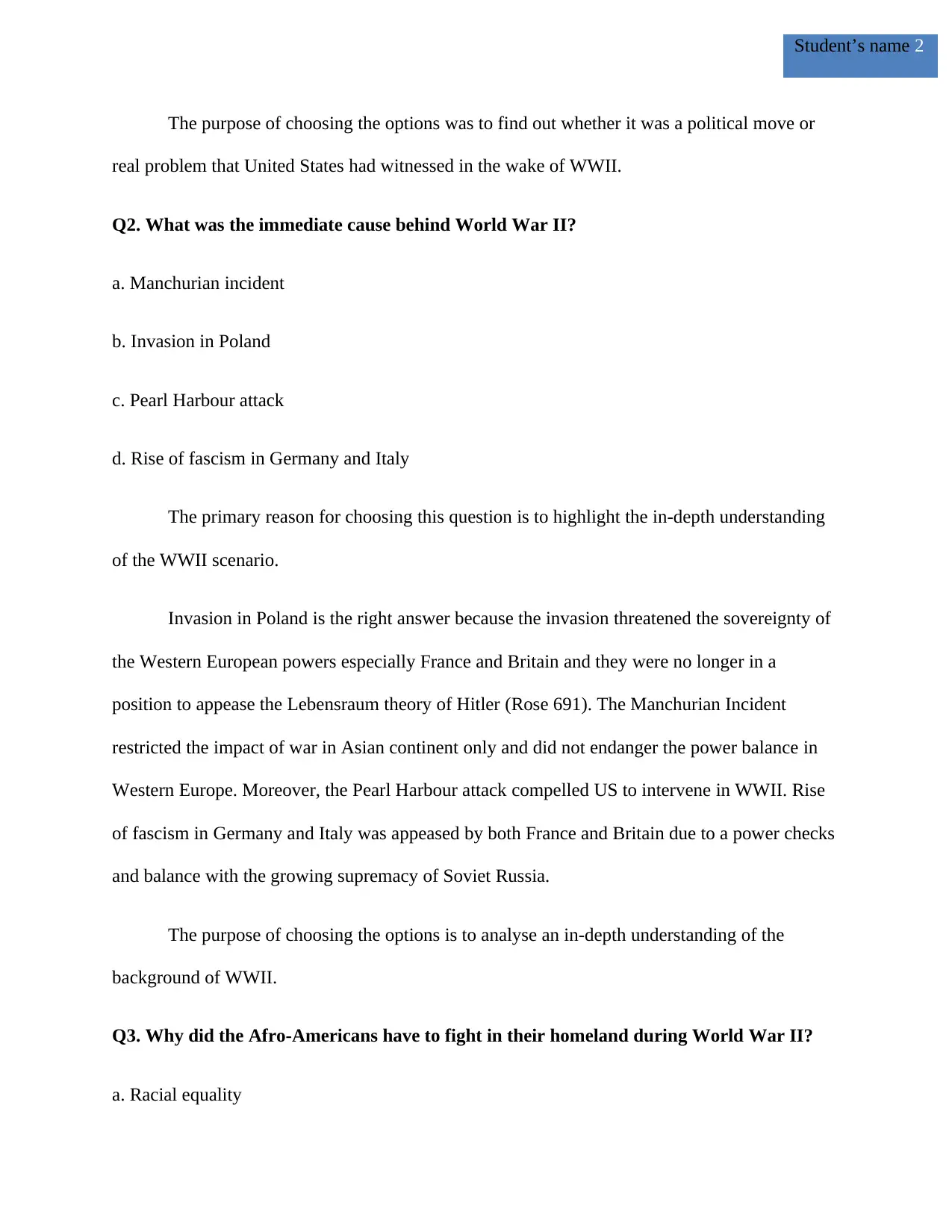
Student’s name 2
The purpose of choosing the options was to find out whether it was a political move or
real problem that United States had witnessed in the wake of WWII.
Q2. What was the immediate cause behind World War II?
a. Manchurian incident
b. Invasion in Poland
c. Pearl Harbour attack
d. Rise of fascism in Germany and Italy
The primary reason for choosing this question is to highlight the in-depth understanding
of the WWII scenario.
Invasion in Poland is the right answer because the invasion threatened the sovereignty of
the Western European powers especially France and Britain and they were no longer in a
position to appease the Lebensraum theory of Hitler (Rose 691). The Manchurian Incident
restricted the impact of war in Asian continent only and did not endanger the power balance in
Western Europe. Moreover, the Pearl Harbour attack compelled US to intervene in WWII. Rise
of fascism in Germany and Italy was appeased by both France and Britain due to a power checks
and balance with the growing supremacy of Soviet Russia.
The purpose of choosing the options is to analyse an in-depth understanding of the
background of WWII.
Q3. Why did the Afro-Americans have to fight in their homeland during World War II?
a. Racial equality
The purpose of choosing the options was to find out whether it was a political move or
real problem that United States had witnessed in the wake of WWII.
Q2. What was the immediate cause behind World War II?
a. Manchurian incident
b. Invasion in Poland
c. Pearl Harbour attack
d. Rise of fascism in Germany and Italy
The primary reason for choosing this question is to highlight the in-depth understanding
of the WWII scenario.
Invasion in Poland is the right answer because the invasion threatened the sovereignty of
the Western European powers especially France and Britain and they were no longer in a
position to appease the Lebensraum theory of Hitler (Rose 691). The Manchurian Incident
restricted the impact of war in Asian continent only and did not endanger the power balance in
Western Europe. Moreover, the Pearl Harbour attack compelled US to intervene in WWII. Rise
of fascism in Germany and Italy was appeased by both France and Britain due to a power checks
and balance with the growing supremacy of Soviet Russia.
The purpose of choosing the options is to analyse an in-depth understanding of the
background of WWII.
Q3. Why did the Afro-Americans have to fight in their homeland during World War II?
a. Racial equality
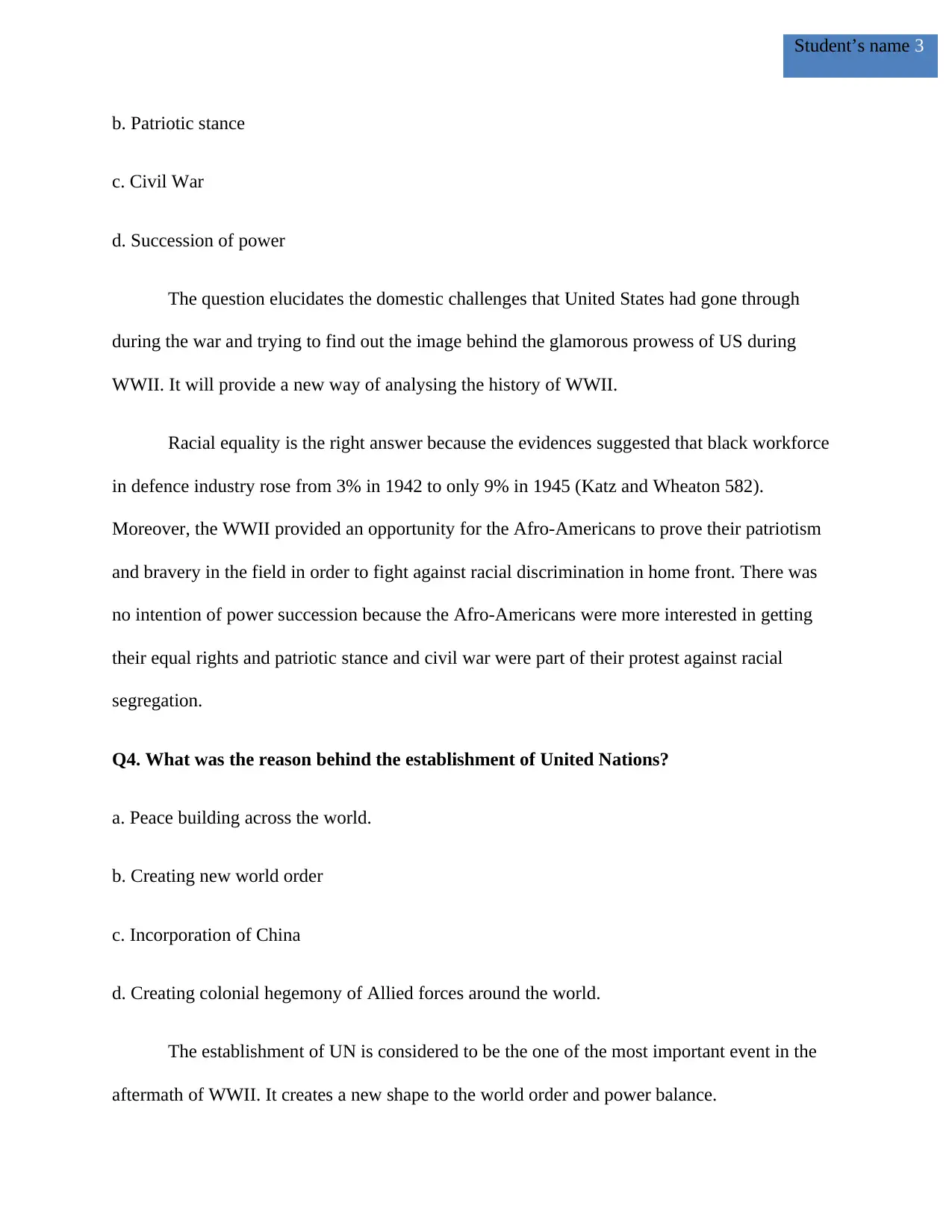
Student’s name 3
b. Patriotic stance
c. Civil War
d. Succession of power
The question elucidates the domestic challenges that United States had gone through
during the war and trying to find out the image behind the glamorous prowess of US during
WWII. It will provide a new way of analysing the history of WWII.
Racial equality is the right answer because the evidences suggested that black workforce
in defence industry rose from 3% in 1942 to only 9% in 1945 (Katz and Wheaton 582).
Moreover, the WWII provided an opportunity for the Afro-Americans to prove their patriotism
and bravery in the field in order to fight against racial discrimination in home front. There was
no intention of power succession because the Afro-Americans were more interested in getting
their equal rights and patriotic stance and civil war were part of their protest against racial
segregation.
Q4. What was the reason behind the establishment of United Nations?
a. Peace building across the world.
b. Creating new world order
c. Incorporation of China
d. Creating colonial hegemony of Allied forces around the world.
The establishment of UN is considered to be the one of the most important event in the
aftermath of WWII. It creates a new shape to the world order and power balance.
b. Patriotic stance
c. Civil War
d. Succession of power
The question elucidates the domestic challenges that United States had gone through
during the war and trying to find out the image behind the glamorous prowess of US during
WWII. It will provide a new way of analysing the history of WWII.
Racial equality is the right answer because the evidences suggested that black workforce
in defence industry rose from 3% in 1942 to only 9% in 1945 (Katz and Wheaton 582).
Moreover, the WWII provided an opportunity for the Afro-Americans to prove their patriotism
and bravery in the field in order to fight against racial discrimination in home front. There was
no intention of power succession because the Afro-Americans were more interested in getting
their equal rights and patriotic stance and civil war were part of their protest against racial
segregation.
Q4. What was the reason behind the establishment of United Nations?
a. Peace building across the world.
b. Creating new world order
c. Incorporation of China
d. Creating colonial hegemony of Allied forces around the world.
The establishment of UN is considered to be the one of the most important event in the
aftermath of WWII. It creates a new shape to the world order and power balance.
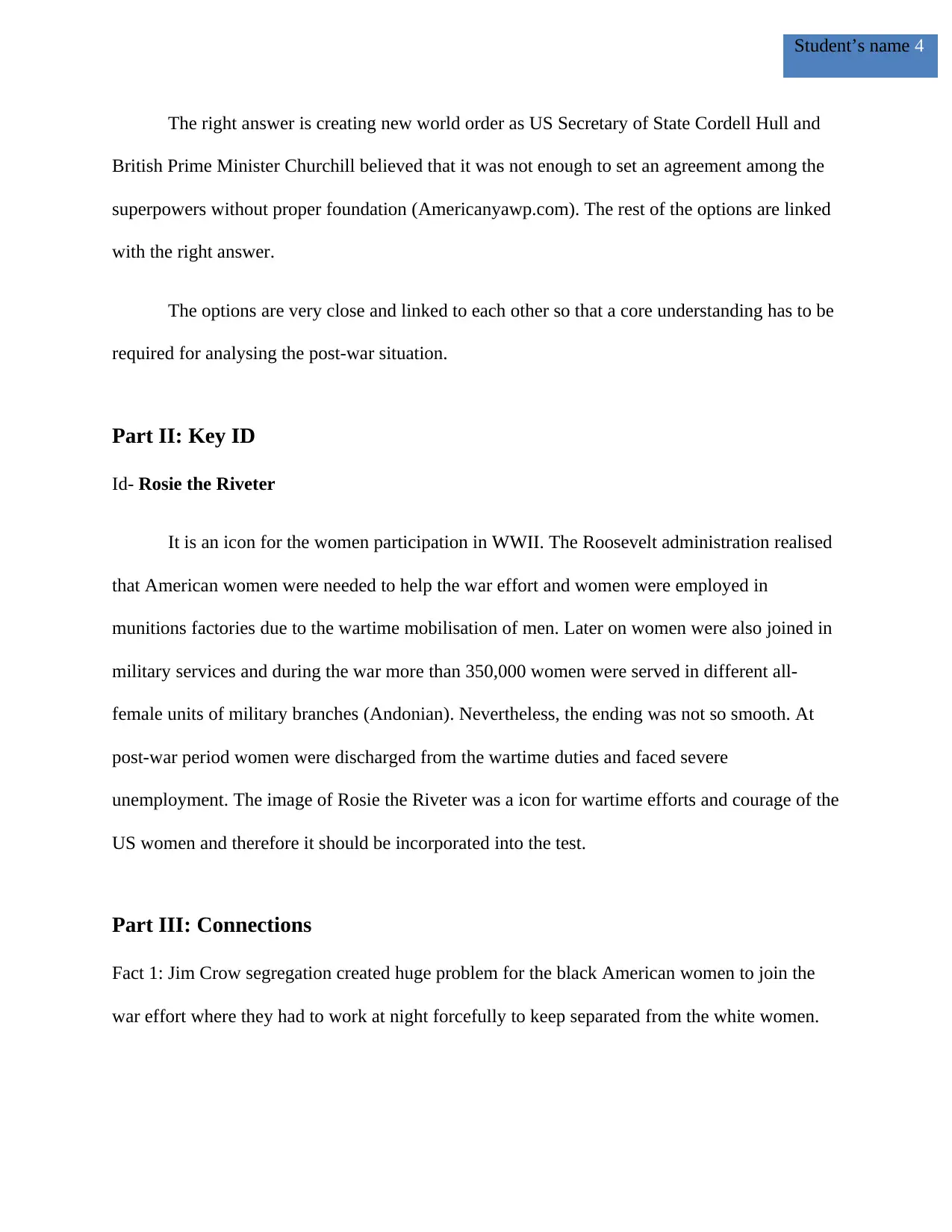
Student’s name 4
The right answer is creating new world order as US Secretary of State Cordell Hull and
British Prime Minister Churchill believed that it was not enough to set an agreement among the
superpowers without proper foundation (Americanyawp.com). The rest of the options are linked
with the right answer.
The options are very close and linked to each other so that a core understanding has to be
required for analysing the post-war situation.
Part II: Key ID
Id- Rosie the Riveter
It is an icon for the women participation in WWII. The Roosevelt administration realised
that American women were needed to help the war effort and women were employed in
munitions factories due to the wartime mobilisation of men. Later on women were also joined in
military services and during the war more than 350,000 women were served in different all-
female units of military branches (Andonian). Nevertheless, the ending was not so smooth. At
post-war period women were discharged from the wartime duties and faced severe
unemployment. The image of Rosie the Riveter was a icon for wartime efforts and courage of the
US women and therefore it should be incorporated into the test.
Part III: Connections
Fact 1: Jim Crow segregation created huge problem for the black American women to join the
war effort where they had to work at night forcefully to keep separated from the white women.
The right answer is creating new world order as US Secretary of State Cordell Hull and
British Prime Minister Churchill believed that it was not enough to set an agreement among the
superpowers without proper foundation (Americanyawp.com). The rest of the options are linked
with the right answer.
The options are very close and linked to each other so that a core understanding has to be
required for analysing the post-war situation.
Part II: Key ID
Id- Rosie the Riveter
It is an icon for the women participation in WWII. The Roosevelt administration realised
that American women were needed to help the war effort and women were employed in
munitions factories due to the wartime mobilisation of men. Later on women were also joined in
military services and during the war more than 350,000 women were served in different all-
female units of military branches (Andonian). Nevertheless, the ending was not so smooth. At
post-war period women were discharged from the wartime duties and faced severe
unemployment. The image of Rosie the Riveter was a icon for wartime efforts and courage of the
US women and therefore it should be incorporated into the test.
Part III: Connections
Fact 1: Jim Crow segregation created huge problem for the black American women to join the
war effort where they had to work at night forcefully to keep separated from the white women.
Secure Best Marks with AI Grader
Need help grading? Try our AI Grader for instant feedback on your assignments.
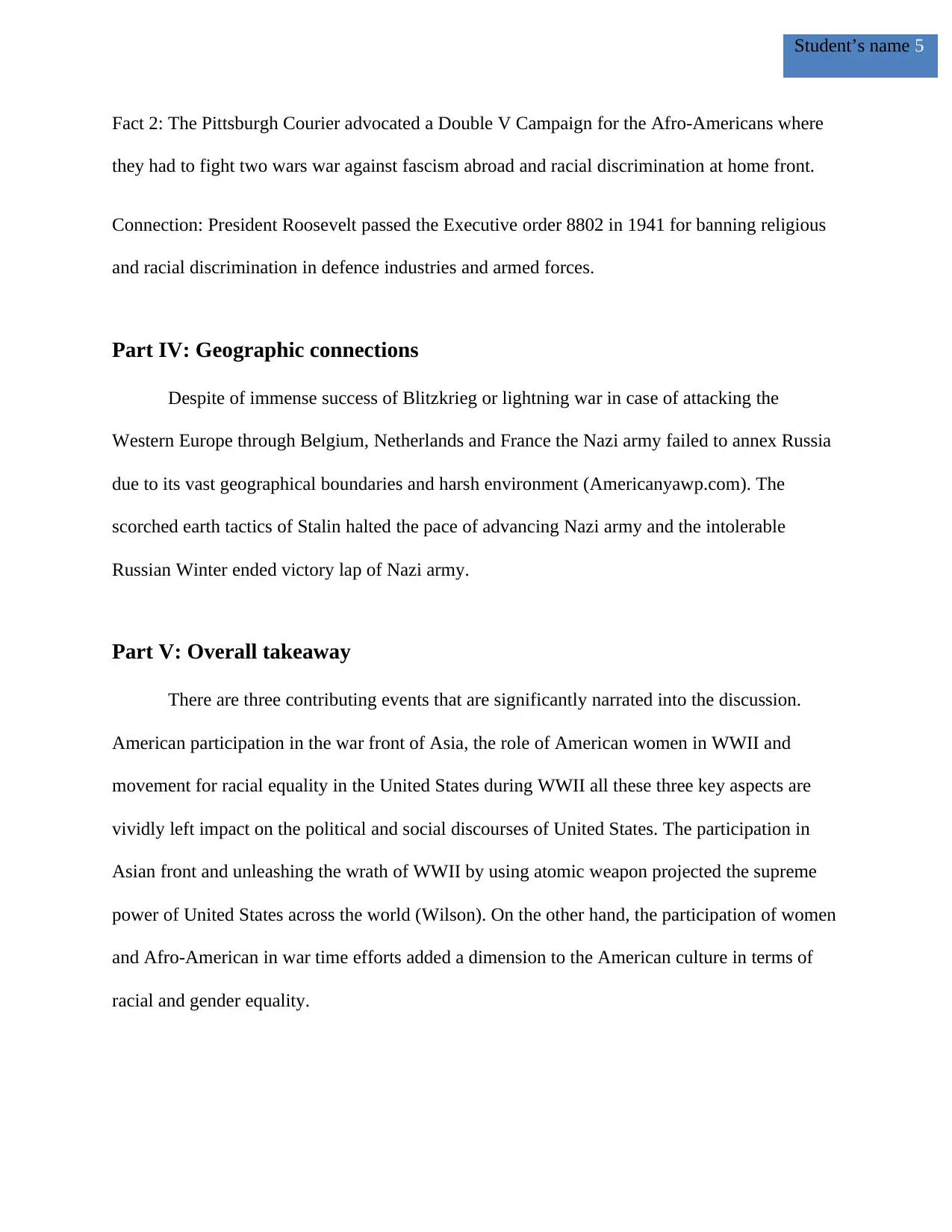
Student’s name 5
Fact 2: The Pittsburgh Courier advocated a Double V Campaign for the Afro-Americans where
they had to fight two wars war against fascism abroad and racial discrimination at home front.
Connection: President Roosevelt passed the Executive order 8802 in 1941 for banning religious
and racial discrimination in defence industries and armed forces.
Part IV: Geographic connections
Despite of immense success of Blitzkrieg or lightning war in case of attacking the
Western Europe through Belgium, Netherlands and France the Nazi army failed to annex Russia
due to its vast geographical boundaries and harsh environment (Americanyawp.com). The
scorched earth tactics of Stalin halted the pace of advancing Nazi army and the intolerable
Russian Winter ended victory lap of Nazi army.
Part V: Overall takeaway
There are three contributing events that are significantly narrated into the discussion.
American participation in the war front of Asia, the role of American women in WWII and
movement for racial equality in the United States during WWII all these three key aspects are
vividly left impact on the political and social discourses of United States. The participation in
Asian front and unleashing the wrath of WWII by using atomic weapon projected the supreme
power of United States across the world (Wilson). On the other hand, the participation of women
and Afro-American in war time efforts added a dimension to the American culture in terms of
racial and gender equality.
Fact 2: The Pittsburgh Courier advocated a Double V Campaign for the Afro-Americans where
they had to fight two wars war against fascism abroad and racial discrimination at home front.
Connection: President Roosevelt passed the Executive order 8802 in 1941 for banning religious
and racial discrimination in defence industries and armed forces.
Part IV: Geographic connections
Despite of immense success of Blitzkrieg or lightning war in case of attacking the
Western Europe through Belgium, Netherlands and France the Nazi army failed to annex Russia
due to its vast geographical boundaries and harsh environment (Americanyawp.com). The
scorched earth tactics of Stalin halted the pace of advancing Nazi army and the intolerable
Russian Winter ended victory lap of Nazi army.
Part V: Overall takeaway
There are three contributing events that are significantly narrated into the discussion.
American participation in the war front of Asia, the role of American women in WWII and
movement for racial equality in the United States during WWII all these three key aspects are
vividly left impact on the political and social discourses of United States. The participation in
Asian front and unleashing the wrath of WWII by using atomic weapon projected the supreme
power of United States across the world (Wilson). On the other hand, the participation of women
and Afro-American in war time efforts added a dimension to the American culture in terms of
racial and gender equality.
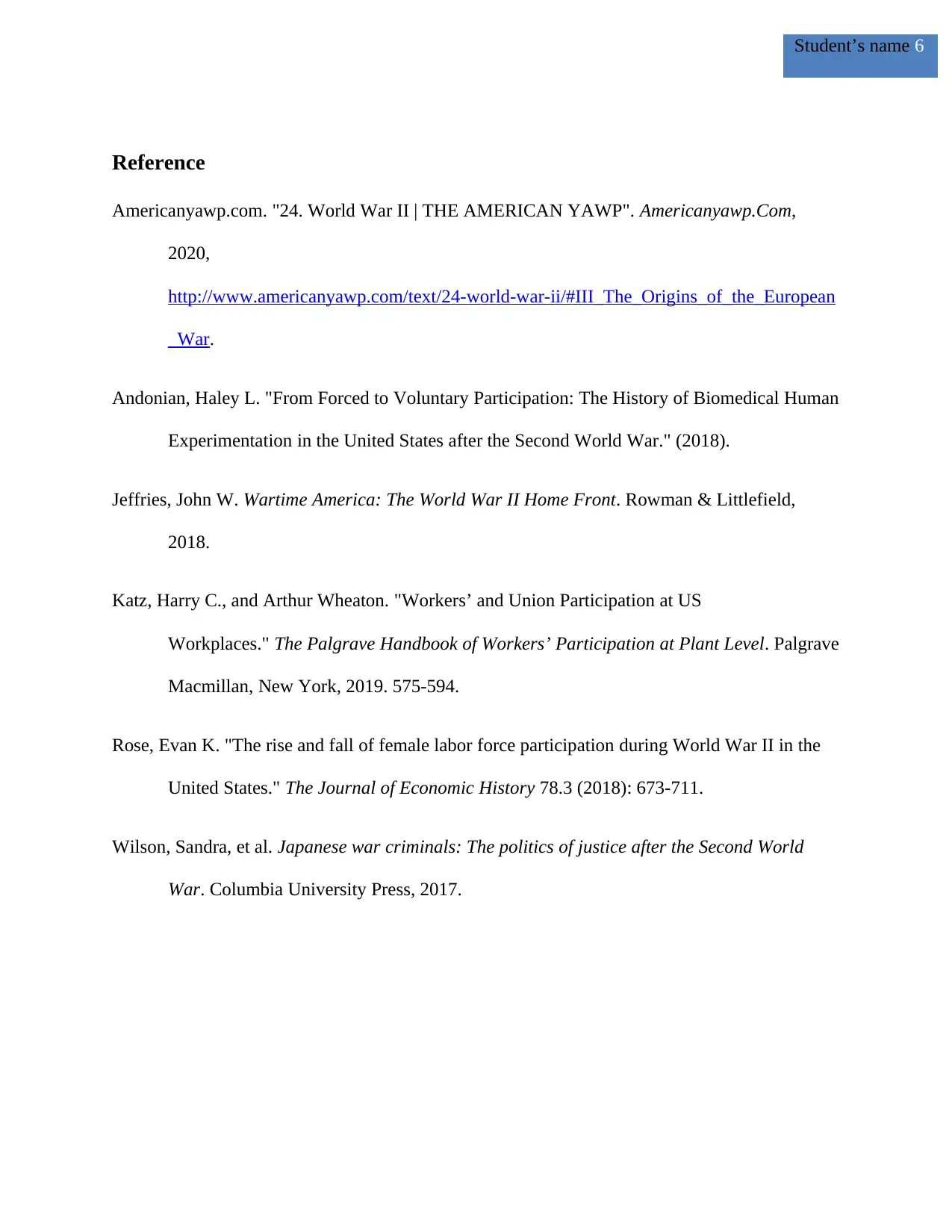
Student’s name 6
Reference
Americanyawp.com. "24. World War II | THE AMERICAN YAWP". Americanyawp.Com,
2020,
http://www.americanyawp.com/text/24-world-war-ii/#III_The_Origins_of_the_European
_War.
Andonian, Haley L. "From Forced to Voluntary Participation: The History of Biomedical Human
Experimentation in the United States after the Second World War." (2018).
Jeffries, John W. Wartime America: The World War II Home Front. Rowman & Littlefield,
2018.
Katz, Harry C., and Arthur Wheaton. "Workers’ and Union Participation at US
Workplaces." The Palgrave Handbook of Workers’ Participation at Plant Level. Palgrave
Macmillan, New York, 2019. 575-594.
Rose, Evan K. "The rise and fall of female labor force participation during World War II in the
United States." The Journal of Economic History 78.3 (2018): 673-711.
Wilson, Sandra, et al. Japanese war criminals: The politics of justice after the Second World
War. Columbia University Press, 2017.
Reference
Americanyawp.com. "24. World War II | THE AMERICAN YAWP". Americanyawp.Com,
2020,
http://www.americanyawp.com/text/24-world-war-ii/#III_The_Origins_of_the_European
_War.
Andonian, Haley L. "From Forced to Voluntary Participation: The History of Biomedical Human
Experimentation in the United States after the Second World War." (2018).
Jeffries, John W. Wartime America: The World War II Home Front. Rowman & Littlefield,
2018.
Katz, Harry C., and Arthur Wheaton. "Workers’ and Union Participation at US
Workplaces." The Palgrave Handbook of Workers’ Participation at Plant Level. Palgrave
Macmillan, New York, 2019. 575-594.
Rose, Evan K. "The rise and fall of female labor force participation during World War II in the
United States." The Journal of Economic History 78.3 (2018): 673-711.
Wilson, Sandra, et al. Japanese war criminals: The politics of justice after the Second World
War. Columbia University Press, 2017.
1 out of 6
Related Documents
Your All-in-One AI-Powered Toolkit for Academic Success.
+13062052269
info@desklib.com
Available 24*7 on WhatsApp / Email
![[object Object]](/_next/static/media/star-bottom.7253800d.svg)
Unlock your academic potential
© 2024 | Zucol Services PVT LTD | All rights reserved.





